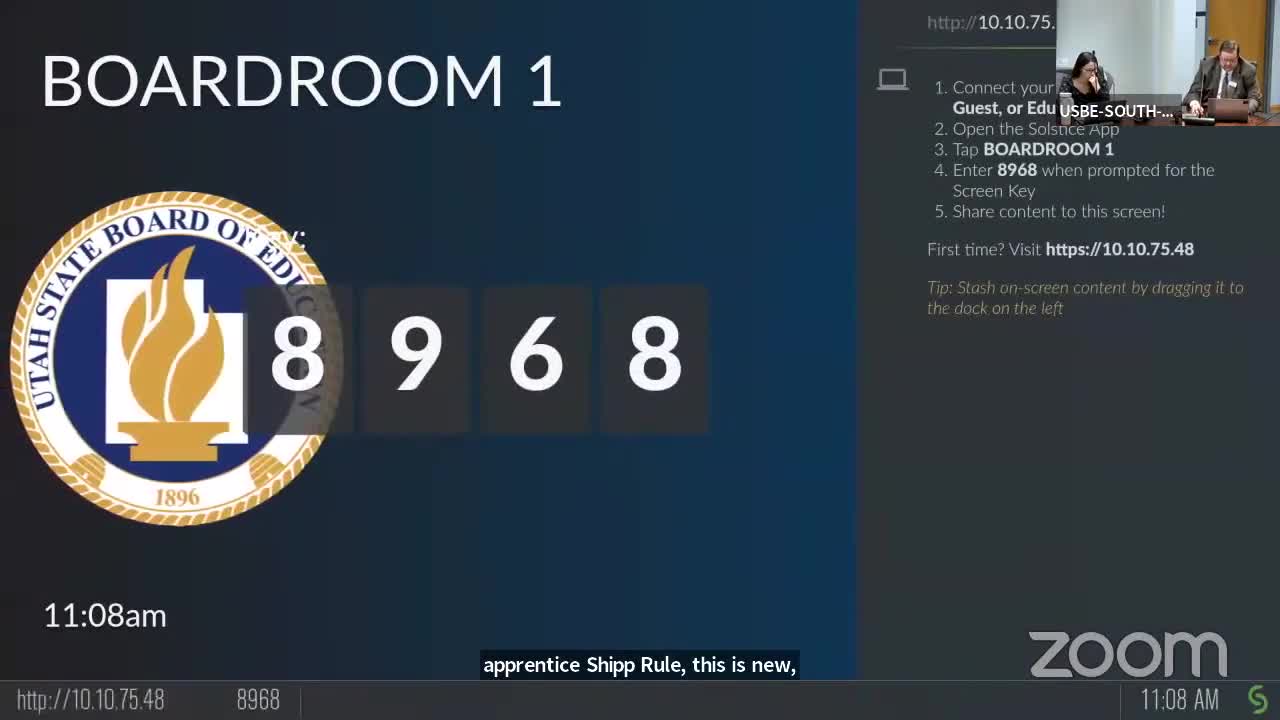Committee approves apprenticeship pathway rule to expand educator pipelines; grant funds to supplement mentor pay
August 03, 2024 | Utah State Board of Education, Utah Education, State Agencies, Organizations, Utah Executive Branch, Utah
This article was created by AI summarizing key points discussed. AI makes mistakes, so for full details and context, please refer to the video of the full meeting. Please report any errors so we can fix them. Report an error »

The Law and Licensing Committee approved R277‑333, a new rule to create an apprenticeship pathway toward educator licensure and clarifies employer‑partner, mentor and apprentice requirements.
Ben Rasmussen, director of law and professional practices, said the rule implements direction in recent legislation and an agreement with the U.S. Department of Labor. Malia Hite, USBE executive coordinator for educator licensing, described operational details including mentor responsibilities, a three‑tiered wage progression tied to demonstration of the board’s general teacher‑preparation competencies, and a role for employer partners.
Committee members asked for clarity on how competency demonstrations translate into wage steps. Malia Hite explained the rule ties wage increases to the board’s 37 general teacher preparation competencies; apprentices who demonstrate 20 competencies reach the first tier, further competencies move them to subsequent tiers, and completing all competencies is required for the professional license. Hite and other staff also confirmed there is federal grant funding available to support the program: about $1.8 million from the U.S. Department of Labor to subsidize apprentice wages, mentor stipends and education costs; no state funding was identified in the discussion.
Member Hart successfully moved an amendment to clarify mentor reimbursement language. The amended provision reads: “The superintendent may reimburse an LEA for mentor compensation for apprenticeship‑related work completed outside of an LEA employment contract for up to $1,000 per assigned apprentice per year.” Staff said that language preserves grant reimbursement while allowing LEAs to pay mentors more from other sources if they choose.
Vice Chair Carey moved approval of the rule on first reading as amended. The committee voted unanimously to forward R277‑333, draft 1 as amended, to the full board for second and final reading.
Implementation notes: Staff will open the program statewide after final rule approval and begin onboarding partner LEAs. The department plans to supplement employer partner costs using the federal grant; LEAs may choose to top up mentor pay from other funding sources if desired.
Questions flagged for staff follow up included non‑substantive drafting cleanups (consistent use of “concurrent enrollment/CE” terminology), clarity on repeated provisions, and clearer presentation of the competency‑to‑wage mapping in the rule text.
Ben Rasmussen, director of law and professional practices, said the rule implements direction in recent legislation and an agreement with the U.S. Department of Labor. Malia Hite, USBE executive coordinator for educator licensing, described operational details including mentor responsibilities, a three‑tiered wage progression tied to demonstration of the board’s general teacher‑preparation competencies, and a role for employer partners.
Committee members asked for clarity on how competency demonstrations translate into wage steps. Malia Hite explained the rule ties wage increases to the board’s 37 general teacher preparation competencies; apprentices who demonstrate 20 competencies reach the first tier, further competencies move them to subsequent tiers, and completing all competencies is required for the professional license. Hite and other staff also confirmed there is federal grant funding available to support the program: about $1.8 million from the U.S. Department of Labor to subsidize apprentice wages, mentor stipends and education costs; no state funding was identified in the discussion.
Member Hart successfully moved an amendment to clarify mentor reimbursement language. The amended provision reads: “The superintendent may reimburse an LEA for mentor compensation for apprenticeship‑related work completed outside of an LEA employment contract for up to $1,000 per assigned apprentice per year.” Staff said that language preserves grant reimbursement while allowing LEAs to pay mentors more from other sources if they choose.
Vice Chair Carey moved approval of the rule on first reading as amended. The committee voted unanimously to forward R277‑333, draft 1 as amended, to the full board for second and final reading.
Implementation notes: Staff will open the program statewide after final rule approval and begin onboarding partner LEAs. The department plans to supplement employer partner costs using the federal grant; LEAs may choose to top up mentor pay from other funding sources if desired.
Questions flagged for staff follow up included non‑substantive drafting cleanups (consistent use of “concurrent enrollment/CE” terminology), clarity on repeated provisions, and clearer presentation of the competency‑to‑wage mapping in the rule text.
View full meeting
This article is based on a recent meeting—watch the full video and explore the complete transcript for deeper insights into the discussion.
View full meeting

